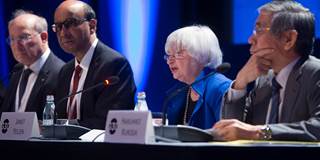In recent years, the world’s major central banks have pursued unprecedentedly easy monetary policies, characterized by ultra-low and even negative interest rates. These policies are turning out to be a classic bad equilibrium: each central bank stands to gain by keeping interest rates low, but, collectively, low rates constitute a trap from which none can escape.
NEW YORK – Global growth seems to be moving, slowly but surely, along the path to recovery. The International Monetary Fund’s latest World Economic Outlook predicts 3.5% global growth this year, up from 3.2% last year. But there’s a hitch: the easy monetary policies that have largely enabled economies to return to growth are reaching their limits, and now threaten to disrupt the recovery by creating the conditions for another financial crisis.
In recent years, the world’s major central banks have pursued unprecedentedly easy monetary policies, including what a recent Deutsche Bank report calls “multi-century all-time lows in interest rates.” That, together with large-scale quantitative easing, has injected a massive $32 trillion into the global economy over the last nine years. But these unconventional policies are turning out to be a classic game-theoretic bad equilibrium: each central bank stands to gain by keeping interest rates low, but, collectively, their approach constitutes a trap.
In today’s globalized world, a slight reduction in interest rates by an individual central bank can bring some benefits, beginning with weakening the currency and thus boosting exports. But the more countries employ this strategy, the greater the strain on the banking sector. This is already apparent in Europe, where bank equity prices have dropped steadily in recent months.

NEW YORK – Global growth seems to be moving, slowly but surely, along the path to recovery. The International Monetary Fund’s latest World Economic Outlook predicts 3.5% global growth this year, up from 3.2% last year. But there’s a hitch: the easy monetary policies that have largely enabled economies to return to growth are reaching their limits, and now threaten to disrupt the recovery by creating the conditions for another financial crisis.
In recent years, the world’s major central banks have pursued unprecedentedly easy monetary policies, including what a recent Deutsche Bank report calls “multi-century all-time lows in interest rates.” That, together with large-scale quantitative easing, has injected a massive $32 trillion into the global economy over the last nine years. But these unconventional policies are turning out to be a classic game-theoretic bad equilibrium: each central bank stands to gain by keeping interest rates low, but, collectively, their approach constitutes a trap.
In today’s globalized world, a slight reduction in interest rates by an individual central bank can bring some benefits, beginning with weakening the currency and thus boosting exports. But the more countries employ this strategy, the greater the strain on the banking sector. This is already apparent in Europe, where bank equity prices have dropped steadily in recent months.